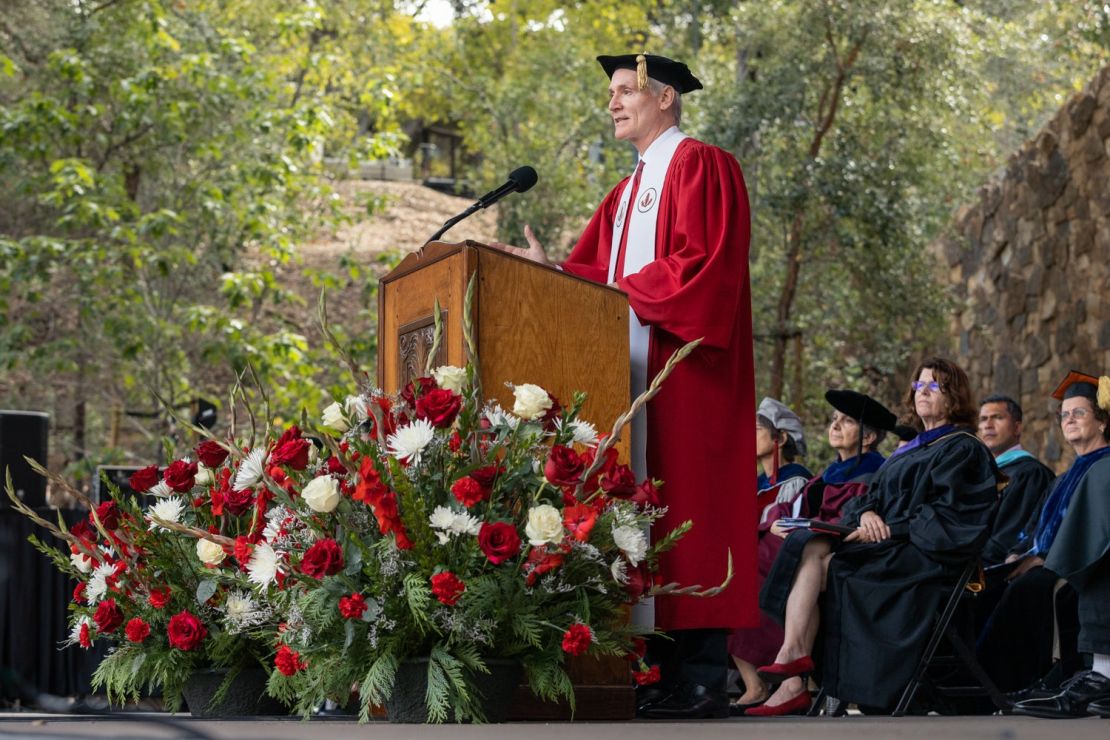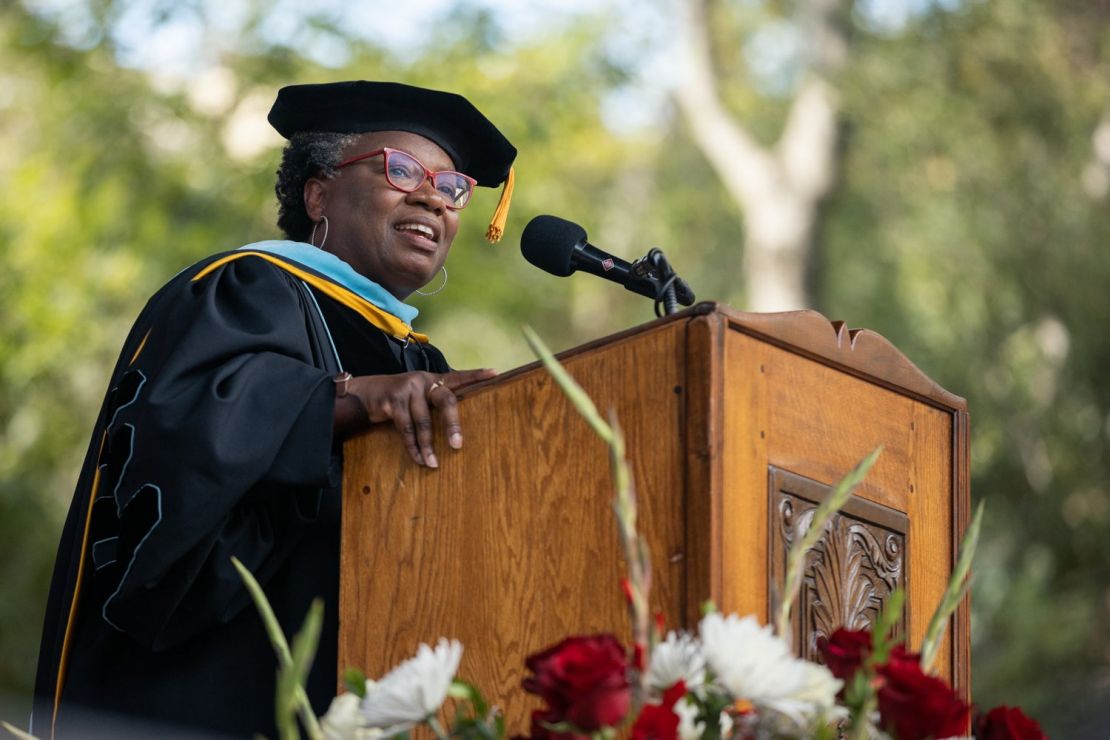In his address at Stanford’s 132nd Convocation ceremony Wednesday morning, President Marc Tessier-Lavigne told new students that despite the many challenges the world faces, the energy, optimism, and sense of purpose on which the university was founded remains alive and well at Stanford today.
Go to the web site to view the video.
“No matter what field you go into, Stanford offers the opportunity to find your own path so that you can both find personal fulfillment and also contribute to your own community or to our wider world,” he said.
Thousands of new students, family members, and other guests gathered at Frost Amphitheater for the annual ceremony, which is a time-honored tradition that serves as the formal inauguration of the academic year. The gathering also kicks off New Student Orientation, or NSO, a weeklong series of events to welcome new students to Stanford and help them acclimate to life on the Farm.
Wednesday’s ceremony opened with a formal procession led by flag bearers, music by the Peninsula Brass Quintet, and a greeting by the Rev. Tiffany Steinwert, dean for religious and spiritual life. That was followed by the university’s land acknowledgment, which was delivered by senior Alyssa Charley, a member of the Navajo Nation.
“We recognize that Stanford sits on the ancestral land of the Muwekma Ohlone Tribe. This land was and continues to be of great importance to the Ohlone people,” Charley said. “Consistent with our values of community and inclusion, we have a responsibility to acknowledge, honor, and make visible the university’s relationship to Native peoples.”
Exploring broadly, engaging deeply
In his address, Tessier-Lavigne told students that their experiences and growth will come both from their academics and the communities they form.

Stanford President Marc Tessier-Lavigne addresses new students at Convocation. (Image credit: Andrew Brodhead)
“I urge you to prepare for the future in two important ways: by exploring broadly and by engaging deeply,” he said, adding that after years of preparing for college, there’s never been a better time for the students to explore their interests.
“You may never again have an opportunity to pursue ideas in as expansive and unfettered a way as during your college years,” he said. “So, I urge you to take a wide range of courses: from medieval literature to international relations, from astrophysics to art history, and from biomechanical engineering to sustainable cities, a course offered in our newest school, the Stanford Doerr School of Sustainability.”
Exploration, he said, is fun and often teaches us things that may not seem immediately practical but can be useful in the future. Tessier-Lavigne noted that when Steve Jobs spoke at Stanford’s Commencement ceremony in 2005, he shared that a calligraphy course he took in college turned out to be fascinating to him. Years later, that knowledge proved invaluable as he designed the Macintosh and made it the first computer to incorporate great typography.
Tessier-Lavigne also said that exploration is the best way to prepare for an uncertain future full of change.
“Encountering different ways of thinking and fields of study in college will help you develop the ability to continually take in new information and to adapt to new ideas throughout the course of your life,” he said, adding that the last few years have shown us how change can happen in an instant. “Exploration will teach you nimbleness, openness, and prepare you for a lifetime of learning.”
Tessier-Lavigne called on students to engage deeply in their chosen fields by seeking out mentors who can guide them in new and interesting directions. He also urged them to participate in hands-on research, which will give them the exhilarating experience of contributing to discovery.
“It will also help you refine your abilities, to ask precise questions and assess data,” he said. “It will, broadly, exercise and improve your critical thinking skills.”
Finally, Tessier-Lavigne called on students to engage with and support one another through their Stanford journey: “You have the opportunity to develop rich social networks and great friendships, many of which will last a lifetime.”
Welcoming a diverse cohort
In addition to President Tessier-Lavigne, speakers included Richard Shaw, dean of admission and financial aid. In his address, Shaw noted the diversity of the new class and the many walks of life from which they come. As of Wednesday, 1,738 first-year students and 47 transfer students are matriculating at Stanford. They come from all 50 states and 75 countries, from Zimbabwe to Australia to Ukraine. Thirteen percent of new students are international citizens, and 77 unique languages other than English are spoken in their homes.
The new students attended 1,277 secondary schools and 13 were home-schooled. Transfer students come from 43 colleges and universities, including 24 community colleges. Among the class of 2026, 21% are the first in their families to attend a four-year university.
Sarah Church, vice provost for undergraduate education, told the diverse cohort that they were accepted to Stanford unconditionally. “This isn’t a community in which you need to recalibrate to fit in,” she said. “You got here by being you.”
Dean of Students Mona Hicks echoed that sentiment by reminding students that they belong at Stanford.
“This is your home!” she said, noting that community and belonging are at the cornerstone of Stanford’s neighborhood residential model. “We want each of you to feel seen within your communities, feel connected, cared about, accepted, respected, and valued.”
The student address was given by Chinemere Uche, a senior studying engineering. In his remarks, Uche said that the COVID-19 pandemic forced him to reconsider what he wanted for his life. He eventually changed his major and participated in the Stanford in New York program, where he found new mentors, experiences, and a passion for human rights.
“Don’t put pressure on yourself to have it all figured out right now,” he said. “Let yourself try different things. Fail a few times, even, and have new experiences. Learn who you are. Learn what you want. And then go get it.”
Orientating Stanford
Convocation is one of the signature events of NSO, the multi-day orientation designed to introduce new students to the rich academic, social, and cultural life at Stanford. It immediately followed Move-In Day on Tuesday, during which new students arrived at Stanford and checked into their campus residences.
NSO will continue through the weekend with numerous events and opportunities designed to help students acclimate to the Farm. On Thursday from 4 to 5 p.m., President Tessier-Lavigne and his wife, Dr. Mary Hynes, will host an informal reception for undergraduates at the Hoover House lawn. Other core NSO programs include “Discover Stanford,” which will include remarks from Provost Persis Drell and Assistant Vice Provost for Residential Education Cheryl Brown, and “Faces of Community,” which will cover issues related to diversity, equity, inclusion, and belonging.
Several events are designed for new students and their families, including welcome gatherings in the residences, lunch in the dining halls, and a panel event for parents to learn how to support their student while they’re at Stanford.
Students will have the opportunity to engage in several in-person social events, held in partnership with many campus offices. They include neighborhood barbecues, Music & Fun Under the Sun (MuFuUnSun), the Roble Arts Gym Open House, and Arcade Night with Trees.
During NSO week, students will get to learn about the many public service opportunities available at Stanford. On Saturday, Sept. 24, all students are invited to attend the Cardinal Service Fair from 2 to 4 p.m. at Wilbur Field. At the event – sponsored by the Haas Center for Public Service – students will get to explore dozens of public service organizations. Throughout fall quarter, the What Do You StandFor? campaign will continue to encourage them to explore such opportunities, which include courses and events, like Festifall.
To ensure the health and safety of everyone participating in NSO, most programs are held outdoors. Students will be asked to mask for indoor programs and encouraged to mask for outdoor programs when social distancing is not possible. Masking is required in all residential indoor common spaces.
For more information about NSO, including an orientation schedule, visit the New Student Orientation website.
Watch the video of the 132nd Convocation ceremony.

